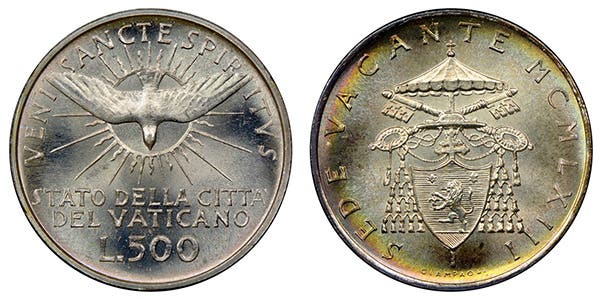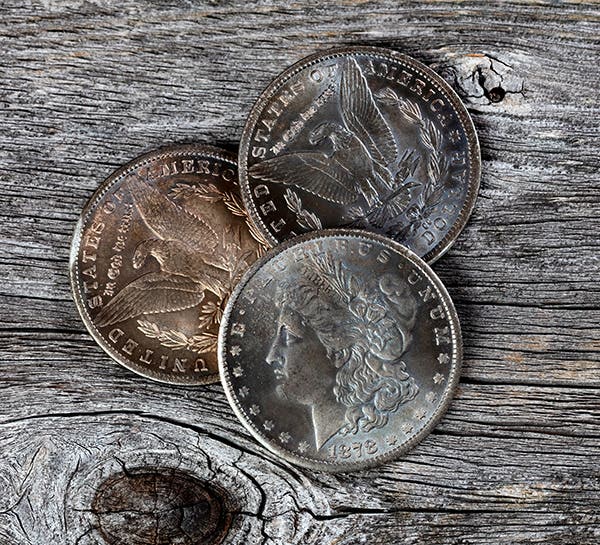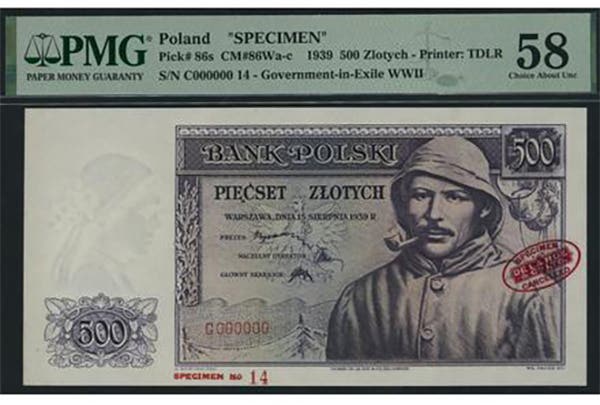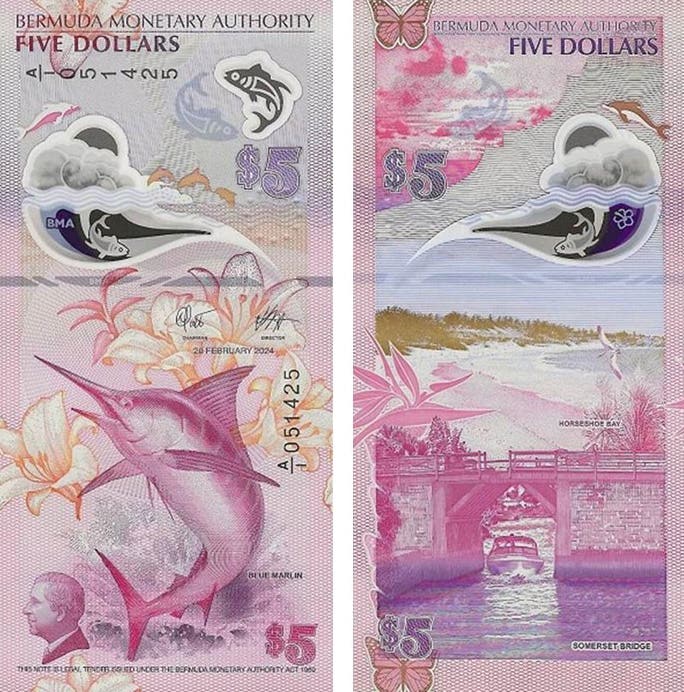The Sale of An Elusive $1 SC 1935D Note
A rare find in the world of small-size paper money—Bruce Scherker’s discovery of a 1935D $1 silver certificate narrow back UE block at the 2024 ANA Convention marks a major numismatic win. Just how elusive is this note, and why does it stand out among the coveted Series of 1935 silver certificates?
This article celebrates Bruce Scherker’s fortuitous purchase at the 2024 American Numismatic Association Convention in Chicago of a $1 silver certificate “Series of 1935D” narrow back UE block variety. The note is among the rarest varieties by serial number block known in the extensive and avidly collected “Series of 1935” $1 silver certificates.
The known specimens have serial numbers from the middle of the UE serial number block, the first numbered block containing notes printed with the new narrow backs. There should be plenty of them, but there aren’t. This is a case where most of the initial stock printed with the new backs was delayed in reaching the serial number division after a small early burst.
Resizing Program
In December 1947, a program at the Bureau of Engraving and Printing started to standardize the sizes of the face and back intaglio images on the master dies used to make currency plates. The benefit of the resizing program was that the separations between the engravings on the plates were enlarged in the shortened dimensions. The purpose was to reduce spoilage when the notes were cut from the sheets.
In all cases, the altered images were made smaller, thus yielding what we call the narrow varieties. Resizing involved making new master dies. All the altered designs were shortened in the horizontal dimension except for the $1 back, which was shortened from top to bottom.
The standardized images on the face dies were a bit larger than those on the backs, so the separations between the images on the back plates had to be greater than those on the face plates.
The work on the narrow dies commenced on December 11, 1947, when the narrow $5 FRN face die began. It concluded almost three years later with the hardening of the narrow $5 and $10 back dies on September 20, 1950. The standard size for face dies was the existing size of the $1 silver certificate master, so no change was made to it. The standard for the backs was the existing size of the $50 and $100 back dies, so they were left unchanged. The following masters were resized: all $2, $5, $10, $20, $50, $100 face and $1, $5, $10, $20 back dies. Left untouched were the $2, $50, and $100 backs and, of course, the $1 face.
When the new master dies became available, the resized designs were used on 12-subject flat plates mounted on 4-plate presses. The new plates were phased in during a variable transition period for each variety, in which both the wide and narrow variety plates served together, often on the same press, until the stock of wide variety plates was consumed.
Collectors call the old varieties “wide” and the new “narrow.” This nomenclature refers to the dimensions of the intaglio images on the notes, not the overall dimension of the printing plates, which did not change.
Creation of Rarities
The resizing program created many varieties of great interest for small-size note collectors. At the most fundamental level, there were wide and narrow varieties for each affected series and class of notes. Because the wide and narrow plates were mixed on the presses during the transition period, notes came out with wide face/wide back, wide face/narrow back, narrow face/wide back, and narrow face/narrow back varieties. The stream of sheets leaving a given press where wide and narrow plates were used produced changeover serial number pairs between the varieties.
More significantly, the timing of the phase-in of the narrows and phase-out of the wides created rarities owing to serendipitous limited production. Collectors often try to collect each variety by serial number block, that is, by the prefix/suffix letter combination in the serial numbers. This type of collecting is particularly popular for the various $1, $2, and $5 varieties. Some block varieties are very scarce to rare because of factors such as a variety started numbering near the end of a block or plates of a given variety becoming depleted within a block, thus limiting production. This article concerns the narrow back variety found in the UE block of the “Series of 1935D” $1 silver certificates. The UE block was the first to sport the variety.
$1 1935D Narrow Backs
The first back die to be resized was the $1. The new narrow die was completed in May 1949, and the first plate made from it was in September that same year. In this instance, the vertical dimension was shortened, thus becoming the only case of vertical shortening in the resizing program. The slack was taken up by trimming the top and bottom borders. The change occurred during the production of 12-subject $1 “Series of 1935D” silver certificate sheets. The changeover plates bore serial numbers 5015 and 5017, which are found inside the lower right corners of the notes.
The transition period, during which wide and narrow $1 back plates were in simultaneous use, lasted three and a half years until March 1953. It spanned 20 serial number blocks, including prefix/suffix letters UE through MG and *B and *C, but not GG. The GG block was used exclusively for early 18-subject production, so all had narrow backs.
Block UE was the first to sport narrow backs. For an unknown reason, few were printed. Despite the variety being known since at least the 1970s, I have only been able to verify the existence of two survivors with photographs.
The master narrow-back die was hardened on May 10, 1949. The first $1 narrow-back plates were certified on September 22, 1949, and the first day a $1 narrow-back plate was used on a press was September 28, 1949. The earliest the faces could have been printed on the narrow-back sheets was October 1949, followed by a week or more before they were numbered. The UE block was numbered from September 30, 1949, to November 4, 1949.
Reported UE Narrows
The serials on the reported 1935D narrow UE notes are Bruce Scherker’s U54720688E and the late Jim Thompson’s U54722558E. Thompson’s note was sold in a Lyn Knight auction in 1998. Both are from the middle of the UE block printed in mid-October 1949, when the first variety should have appeared. The irony is that there were 50 million serials left to number in the UE block, yet no narrows have been reported from this huge range. I have no technical explanation for this lapse.
A problem with this variety is that to find one, you have to know it exists—the variety is visually subtle—and that the rare block for it is the UE. Many serious $1 SC block collectors chased the 1935 SC series during the last third of the 1970s, with several knowledgeable dealers handling them and catalog listings for the variety. Yet, they weren’t found despite thousands of 1935D notes passing through knowledgeable hands. I do not doubt that others out there that simply haven’t been recognized. If you find, have, or know of one, let me know and provide scans of both the face and back.
Right Time at the Right Place
Bruce Scherker obtained U54720688E D6020/5017 at the 2024 ANA convention in Chicago. A broker for a deceased California collector brought it to the show and flashed it around, turning down a $1,000 offer before finding Andy Timmerman of Kearney Coin Center. Knowing Bruce’s cravings and that he was at the show, Andy called him to the floor to determine if he was a candidate for it.
Bruce admits, “Well, my heart was racing with excitement at the possibility of owning it.” He unflinchingly leaped at the opportunity. A deal was consummated, and this lucky collector at the show walked out with the prize.
This was not the least of Bruce’s good fortune. Adding icing to the cake, he discovered that the back plate serial number 5017 on his note was the first narrow production plate and among the first certified for use on September 22, 1949. In contrast, the Thompson note is from back 5023.
Bruce contacted me, wondering if I’d be interested in writing an article about it. Little did he know that I have always had a weakness for 1935 silvers. They were the first notes I ever collected, beginning in junior high in the 1950s. Of course, I knew about the UE narrow but had never seen one. I did know the lowest observed serial was listed in the Schwartz-Lindquist catalog, so I looked it up. To both our surprise, it turned out to be Bruce’s note.
Chuck O’Donnell knew the variety in the 1970s but didn’t list a sighting by serial. I suspect he had seen or received a report of Bruce’s note back then. It was probably the first to be numismatically discovered.
You may also like:








